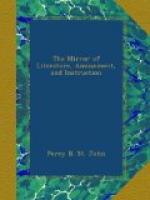“I rode one day on purpose to see Cooper’s Hill, because Mr. Denham had written a poem upon it; and hearing that Cowley was coming to see Mr. Evelyn at Wootton, I went there and waited all the morning, till I saw him arrive. He had a book in his hand, with his finger between the leaves, as if he had been reading. He was a fleshy, heavy man, not looking in good health, and had something of a stare in his eye. Before he entered the gate, he stooped down to pinch the cheeks of some little children at play; and afterwards, when I heard he was put in prison, I could not, for the life of me, persuade myself that he deserved it.”
The third chapter describes one of Charles’s visits to Durdans, a rural retreat built with materials from Nonsuch in the vicinity. The opening has all the summer freshness of a race-day morning at Epsom:
“The bells awoke me in the morning, ringing a merry peal. When the wind died, they seemed to be calling towards London; when it rose again, they poured their merriment through the town, as if telling us that the King was coming. I got up, and went into the street, where the people were having their breakfasts under the trees, as the gentry do in the time of the races. It was a very animated scene. The morning was brilliant. A fine air tempered the coming warmth. The tables set out with creams and cakes under the trees, had a pretty country look, though the place was crowded. Everybody was laughing, chattering, and expecting; and the lasses, in their boddices and white sleeves, reminded me of Miss Warmestre.”
The arrival of the King and his mistress is beautifully told, as are the costumes described, nay, coloured, for they are like highly-finished portraits.
Charles and his Court at Epsom.
“The King!—The silence now seemed to become more silent; and in spite of the opinions in which I had been brought up, I felt what it was to be in the presence of one who inherited sovereign power. His Majesty himself alighted first, and together with Buckingham, presented his hand to assist the Queen. Then came a handsome boy, Mr. Crofts (afterwards Duke of Monmouth); and last, assisted by her cousin the Duke, the long looked for beauty, beautiful indeed, triumphantly beautiful. She looked around, and the spectators could hardly refrain from another shout.
“The dress at that time was well calculated to set off a woman to advantage. Lady Castlemain was dressed in white and green, with an open boddice of pink, looped with diamonds. Her sleeves were green, looped up full on the shoulders with jewelry, and showing the white shift beneath, richly trimmed with lace. The boddice was long and close, with a very low tucker. The petticoat fell in ample folds, but not so long as to keep the ankles unexposed; and it was relieved from an appearance of too much weight by the very weightiness of the hanging sleeves, which counterpoising its magnitude, and looking flowery




